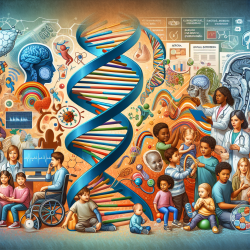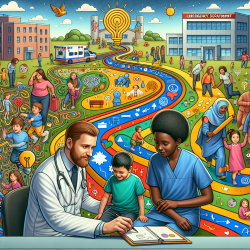Introduction
Speech and language disorders in children are complex conditions with significant genetic contributions. Recent research titled "The clinical and genetic spectrum of paediatric speech and language disorders in 52,143 individuals" provides valuable insights into the genetic underpinnings and clinical presentations of these disorders. This blog aims to help practitioners enhance their skills by applying the outcomes of this research or encouraging further exploration.
Key Findings
The study analyzed a vast dataset from the Electronic Medical Records (EMR) of a large pediatric healthcare network, involving 52,143 individuals. The research identified 26 broad speech and language diagnoses, with the highest frequency of these disorders occurring between ages 2 and 5. Notably, the study highlighted significant comorbidities with neurodevelopmental conditions (30.31%), epilepsies (6.07%), and movement disorders (2.05%).
Genetic Associations
One of the study's critical findings was the identification of specific genetic disorders associated with speech and language phenotypes. The most common genetic disorders were STXBP1, PTEN, and CACNA1A. For instance, STXBP1 was significantly associated with aphasia, while MYO7A was linked to speech and language development delay due to hearing loss.
Implications for Practitioners
Practitioners can leverage these findings to improve diagnostic accuracy and treatment strategies. Here are some actionable steps:
- Utilize EMR Data: Incorporate EMR data analysis into clinical practice to track speech and language disorders over time, enabling better understanding of patient histories and comorbidities.
- Focus on Genetic Testing: Consider genetic testing for patients with unexplained speech and language disorders, especially when associated with neurodevelopmental or epileptic conditions.
- Interdisciplinary Approach: Collaborate with geneticists and neurologists to develop comprehensive care plans that address both the genetic and clinical aspects of these disorders.
Encouraging Further Research
The study underscores the need for continued research into the genetic basis of speech and language disorders. Practitioners are encouraged to participate in or initiate studies that explore genotype-phenotype associations and investigate novel genetic variants.
Conclusion
This research provides a comprehensive overview of the genetic and clinical landscape of pediatric speech and language disorders. By integrating these findings into practice, practitioners can enhance patient care and contribute to the broader understanding of these complex conditions.
To read the original research paper, please follow this link: The clinical and genetic spectrum of paediatric speech and language disorders in 52,143 individuals.










